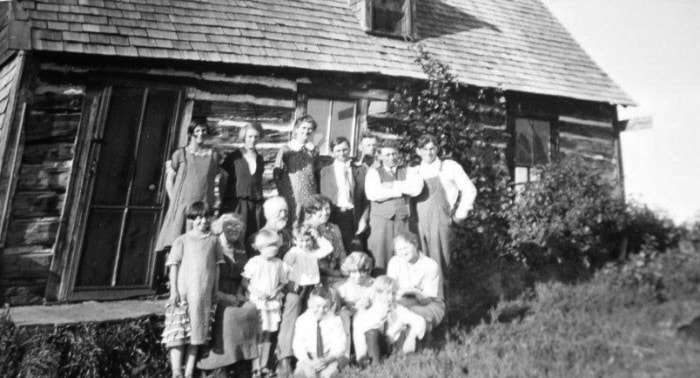It was a wet and rain-filled month of May 1900 when a pair of rugged pioneers, Eben Olmstead and David Wing braved Battle River floods, muskeg and rough Indian trails in search of new farming opportunities on the rolling land west of Ponoka. Their arduous adventure with horse and buggy and on foot turned out to be a great success as they loved what they saw and began to make plans to file their land claims. Shortly after, they returned to South Dakota to pack up all their families and belongings for the long trip on the settler train back to Ponoka in North West Territories to begin a new life on the Alberta prairies. These hardy settlers were given freehold title to their land for $10, but were required to agree to stay on the land for three years, during which they were required to break and plant the land and built a house.
The return of Eb and Alice Olmstead
Eb and Alice Olmstead returned from South Dakota to the tiny Village of Ponoka in 1900, accompanied by their children Olive, Ben, Abbie, and Byron, but left son Elmer with his grandparents in Oklahoma. As well as several railway cars full of furniture, livestock and the rest of their worldly belongings, the family stayed in town for a few months and then in winter the family moved into their new log house at the S.W. of 27, which Eb had built in the fall with the help of his good friend Corliss Wing. Olmstead and Wing also bought the N.E. 23 from the CPR for all the timber growing on it, which was all cut and sawed, then used to construct many of the early buildings in the new district of Dakota.
The following June, a daughter, Zella, arrived and became the first child born in the new settlement of Dakota, and then another brother, Milton, was welcomed in 1904. Eb and Alice would sadly realize during the first spring on their new homestead that the building location was to wet and besieged by floods, so they built a much larger log house on higher ground, in which they lived until 1938, when they moved into a magnificent new home nearer to the road into town. Son Elmer and his wife May were reunited with the family in 1917, moving into the Dakota district from Oklahoma and purchasing the S.E. 25 from the Canadian Pacific Railway. They welcomed their four children Amos, Ben, Nellie and Wayne, who all grew up together on the farm until moving to Montana in 1927. Elmer passed away in 1966.
Eb and Alice were a fine and kindly pioneer couple who were always ready to lend a hand throughout the district wherever it was needed. It was during the horrific flu epidemic of 1918 that Eb was one of the few who wasn’t sick and spent countless hours travelling around to help tend to sick as well as do their chores. They also were very dedicated to the growth and success of the Dakota district, promoting the establishment of such vital amenities as the first school and church, the Dakota cemetery, the Ladies’ Aid, and countless sporting venues and activities. In the year of 1927, the Olmsteads had the terrible misfortune of losing their barn to fire, with 15 of the finest horses in the country also being destroyed in the disaster. In later years, good old Eb loved to piece together quilts as well as enjoying a game of crib with everyone who dropped in to their friendly farm home. Alice passed away in 1929, and Eb lived and worked on the farm with his family until his passing in 1944.
As the family farming tradition carried on, Olive married Will Hoar and settled in the Fertile Forest district, and Ben farmed in the Lundgren district until 1939. Abbie taught school at Dakota, Bismarck, and Lundgren, then retired and kept house for her father and Byron until 1945. Byron attended the home school, later pitching for the great Dakota Baseball team for a number of years, while also working around Battle Lake in the lumber camps before coming back home to take over the farming from his father in 1935. Zella Olmstead attended the old Dakota School, took her nursing training in Calgary, then married Herman Hanson in 1920 and settled in the Edberg district. Milton married Emma Cissell and settled in their favourite and now flourishing Dakota district.
Milton and Emma Olmstead and family
Milton and Emma Olmstead, who were married in 1931, lived with Milt’s father on the farm for four years, and then later purchased the N.E. 23 which Eb and Corlis Wing had owned and cleared during the early settlement of the Dakota district. They later moved to their home at the north end of Stewart’s Lake, which they farmed for many years, and loved to welcome grandchildren and neighbours.
Emma taught at Dakota School for a short time following her marriage, then after raising their family of four, continued her teaching career, serving for many years at the Crestomere School. Milt and Emma’s four children are Louise, who married Ronald Doupe of the Dakota district; Kenneth, who married Donna Phillips and settled in Ponoka; Juanita, who married Don Allen and moved to Erskine; and Donna, who married Nick Street, and farmed in the Menaik area. The proud and ongoing legacy and contributions of the Olmsteads and many other families is featured in the magnificent Dakota History Book, which is now on display at the Fort Ostell Museum in Ponoka.
